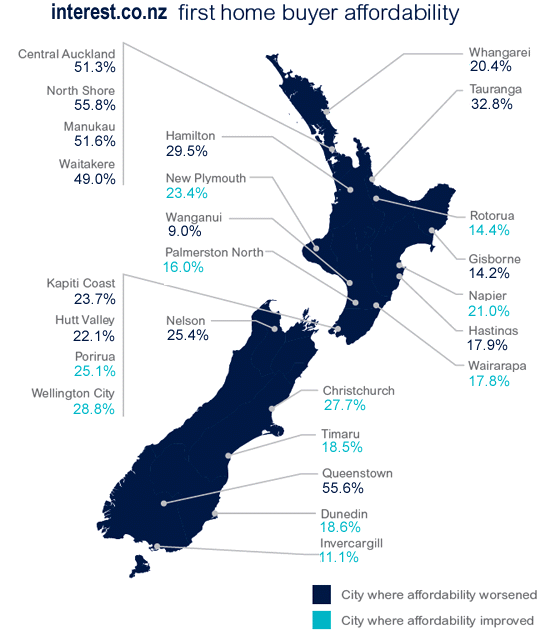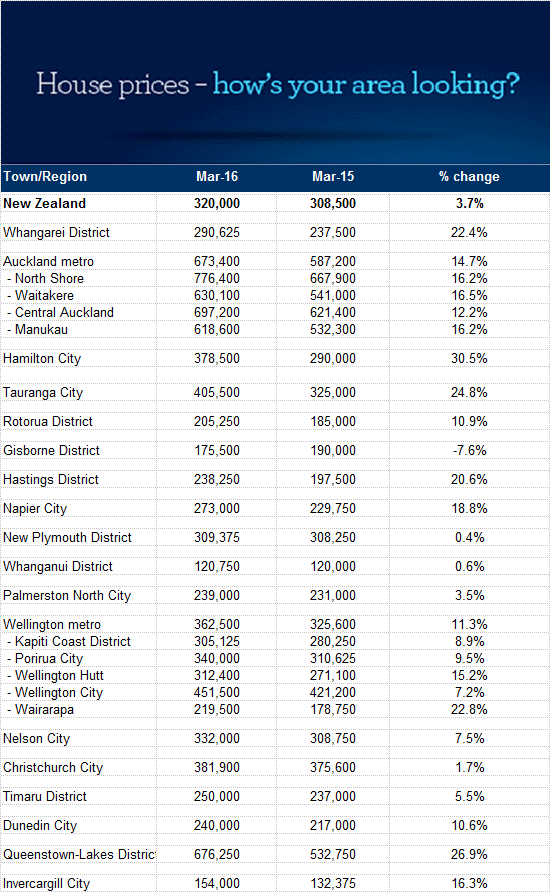
Housing became substantially less affordable for first home buyers in Auckland last month, as a big jump in the region's lower quartile selling price more than offset falls in mortgage interest rates and increases in household income.
But an even bigger jump in prices in Central Otago/Lakes last month has seen the region join Auckland as the only two regions in the country where housing is now unaffordable for typical first home buyers, according to interest.co.nz's Home Loan Affordability Report.
However while home ownership is increasingly out of reach for first home buyers in Auckland and Central Otago/Lakes, the dream of home ownership should still be achievable for first home buyers in all other regions of the country, according to the report.
It found that home loan affordability improved for first home buyers in six regions (Hawkes Bay, Manawatu/Whanganui, Taranaki, Wellington, Canterbury/Westland and Southland) last month, while affordability declined in six regions (Northland, Auckland, Waikato/Bay of Plenty, Nelson/Marlborough, Central Otago/Lakes and Otago).
The biggest declines in affordability for first home buyers were in Central Otago/Lakes, Auckland and Northland, driven by big jumps in the lower quartile selling price of homes in March.
Based on REINZ figures, the lower quartile selling price in Auckland jumped from $629,500 in February to $673,400 in March, an increase of $43,900 (7%) in a month.
That more than wiped out the benefit of falling interest rates, with mortgage payments on a lower-quartile priced home in the region rising from $756.07 a week in February to $806.93 in March, an increase of $50.86 a week.
According to the report, the combined median after tax income for a typical first home buying couple in Auckland (defined as a couple where both are aged aged 25-29 with no children and both working full time) was $1574.81 a week in March, meaning the mortgage payments would be taking up 51.2% of their take home pay, up from 48.2% in February.
Housing is considered unaffordable when mortgage payments take up more than 40% of a household's take home pay.
That was after allowing for a fall in the average two year fixed mortgage rate offered by the major banks, which dropped form 4.54% in February to 4.47% in March.
A similar story was evident for first home buyers in Central Otago/Lakes, where the lower quartile selling price soared from $415,100 in February to $527,000 in March, pushing the mortgage payments on a lower quartile-priced property from $480.11 a week to $619.80, a jump of $139.69 a week.
That means the mortgage payments on a lower quartile-priced home in Central Otago/Lakes would suck up 42.4 % of typical first home buying couple's take home pay, putting the region squarely into unaffordable territory.
In February the mortgage payments on a lower quartile-priced home would have been just 32.9% of a typical first home buying couple's take home pay, which was still considered affordable.
The sharp fall in affordability in Central Otago/Lakes appears to have mainly been driven by huge increases in house prices in Queenstown, which have been rising strongly since the end of last year.
In March the lower quartile house price in Queenstown was $676,250, up a staggering $70,000 compared to February's lower quartile selling price of $606,250.
That means that lower quartile property prices in Queenstown now exceed those in Auckland, making it the most unaffordable place in the country for first home buyers.
It also means that first home buyers on average incomes in Central Otago/Lakes are increasingly likely to have to look outside of the town to find a home they can afford, just as first home buyers in Auckland are being forced to the city fringes or out of the city altogether, or resign themselves to renting.
Compounding the problem for aspiring first home buyers in Auckland and Central Otago/Lakes would be the difficulty they would have in saving a sufficient deposit to buy a home.
According to the Home Loan Affordability Report, if a typical first home buying couple in Auckland saved 20% of their net income a year into an interest bearing account, they would have saved $72,116 after four years, which is just 10.7% of March's lower quartile selling price in Auckland.
In Central Otago/Lakes, a typical first home buying couple would have saved 12.5% of the region's lower quartile selling price after four years.
However buying a home should still be well within affordable limits for typical first home buyers in all other parts of the country.
Although lower quartile prices have been rising in other parts of the country, it is off such a low base that the mortgage payments to buy a lower quartile priced home would be well under the 40% affordability threshold in all regions except Auckland and Central Otago/Lakes.
After Central Otago/Lakes, the next most expensive region in the country is Wellington, where the lower quartile selling price was $362,500 in March.
However the mortgage payments on a lower quartile-priced home in Wellington would only take up 25.5% of a typical first home buying couple's take home pay, and after saving 20% of their income for four years they would have saved a deposit of 20.3% to put towards the purchase of their home.
So buying a home definitely remains achievable for first home buyers on average incomes in all regions of the country except Auckland and Central Otago/Lakes.

Source: CartoonStock. © Used with permission

20 Comments
Petition - foreign buyer can only purchase new build house !!!
Hey! Did I get a mention? Thanks Greg! ;) The deposit is certainly what is killing us...
These reports certainly are interesting thanks. NZ excl. Auckland and Queenstown still looks pretty reasonable.
I also like the photo - reminds me of myself except I am a man, have natural coloured hair and am often smiling.
In other news, science discovers the sky is blue, and water is, in fact, wet.
This Is bizzare stuff
The region is a completely synthetic creation of the tourism industry, without it there is nothing.
Every person that complains knows the short work season but pretends its someone elses problem.
Move to Dunedin and join the unemployment there, at least houses are cheaper.
queenstown prices collapsed in 2009, most was overseas money and it left quick smart.
whos to say wont happen again.
also it is a very expensive place to live compared to others but also a very very beautiful place to visit with heaps to do
Queenstown has no fundamental wealth Wallstreet, but neither does Auckland.
With the International Airport now well servicing the Australian east coast, queenstown is now the perfect location for the commuting executive/miner.I know a number of people who work in remote mining locations (FIFO) and have shipped the family back from Perth/Brisbane. Queenstown offers a fantastic lifestyle esp. if you're booking Aussie dollars. The schools are good and the vista unforgettable.
Dunedin is totally dead. All you hear about is factory closures, the inept local pollies failed to capture any gains from the Christchurch earthquake.
So housing is affordable for all of New Zealand except for 2 regions, yet this article and many others only concentrate on the 2 regions that are unaffordable. Why ???
Did anyone go to the Barfoot & Thompson auction in Shortland Street, Auckland today? I was really shocked by what I saw and the prices have all been blown out of proportion.
Echinops - can you expand? What was it like?
We are all waiting Echinops. I was going to drop in to the auction today as I was walking past but decided not to as no one seemed to appreciate my reporting nor my average sale price over CV analysis. I regret that now.
Yes - what happened at Barfoots - what were u shocked at - real estate agents buying their own listings?
http://i.stuff.co.nz/business/79043677/Barfoot-Thompson-fails-to-overtu…
why are you surprised by the lack of ethics amongst RE agents.
don't have to do much training to qualify
they learn to read and prey on human emotions and nature
and they police themselves
I felt sorry for the agents for having such whiny clients. If my home was on the market for four months not selling and then an agent offered to buy it for a good price I'd be happy. It is intriguing that a property was appraised at $377,166 - that seems a very precise figure.
What I find funny about agents is they often pester you about appraising your home but when at an open home you ask them what they think it will sell for they have often have no idea. They also freak out when you ask them to put an appraisal in writing for tax purposes.
If you've read Phil Anderson's Cycle Theory we're only four years into a fourteen year up-cycle in land values. There will be pullbacks along the way of course but the overall trend will be up. Seems to me we are getting hyperinflation of land values in areas of demand. It could be that this particular cycle is the mother of all booms and has hardly got started let alone ending any time soon. Aggravating factors are the very low interest rates in the economy in terms of yield, the risk of losing your capital in a bank failure (we all know surely that depositing money at your bank is making them a potentially risky unsecured loan), and the attraction of NZ both as a country and a Wild West investment paradise.
This article has a case of schizophrenia - what exactly are we measuring here at the lower quartile - is it houses, homes or properties? All are mentioned above without distinction. Do these values include units and apartments or only houses?
Capital gain tax is in place and is not a big enough deterrent (at the levels it is set at) otherwise we would not be in the state we are in with prices. Investors will buy regardless of capital gains tax or not just like workers work regardless of personal tax or not. 70% of the profits is better than no profits at all.
Stamp duty 10-15% on purchase is the only way to really deter investors from purchasing existing housing stock and using their money "to help provide a service to society" by buying new builds and encourage supply growth. So in this case FHBs buying lower quartile properties will only be competing with other FBH's and not 40%+ investors that they are currently competing against.
The capital gains tax for any property investor is now 30% in most cases - ie buy a rental property now and sell within 2 years and you pay CGT at your personal tax rate. However that will not be a deterent.
I favour CGT but not as a way to stop house prices going up. It doesn't work, unless it is set at a really punitive level (like 40-50%). And then if its set that high it has all sorts of nasty potential unintended consequences...
But it is more equitable, and provides extra government revenue. I favour a CGT at circa 20%. That could then offset a really effective policy initiative like reducing GST on new housing to 7.5%.
One example from Barfoots auction yesterday 68 Kelmarna Ave:
Sold April 2016 $1,215,000
Sold March 2013 $925,000
Sold by Housing NZ Sept 2012 $711,000
CV is exactly one million so looks like a #goodbuy. It is entry level houses in Manurewa, Papatoetoe, Papakura and Manurewa that seem a bit excessive from my observation, often selling at 60%+ over CV. This one is only 20% above.
PS: I see why that was so cheap now - it is a duplex #reasonablebuy.


We welcome your comments below. If you are not already registered, please register to comment.
Remember we welcome robust, respectful and insightful debate. We don't welcome abusive or defamatory comments and will de-register those repeatedly making such comments. Our current comment policy is here.